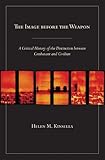The image before the weapon : a critical history of the distinction between combatant and civilian / Helen M. Kinsella.
Material type: TextPublication details: Ithaca : Cornell University Press, (c)2011.Description: 1 online resource (xii, 260 pages)Content type:
TextPublication details: Ithaca : Cornell University Press, (c)2011.Description: 1 online resource (xii, 260 pages)Content type: - text
- computer
- online resource
- 9780801460784
- KZ6515 .I434 2011
- COPYRIGHT NOT covered - Click this link to request copyright permission: https://lib.ciu.edu/copyright-request-form
| Item type | Current library | Collection | Call number | URL | Status | Date due | Barcode | |
|---|---|---|---|---|---|---|---|---|
 Online Book (LOGIN USING YOUR MY CIU LOGIN AND PASSWORD)
Online Book (LOGIN USING YOUR MY CIU LOGIN AND PASSWORD)
|
G. Allen Fleece Library ONLINE | Non-fiction | KZ6515 (Browse shelf(Opens below)) | Link to resource | Available | ocn732957099 |
Includes bibliographies and index.
Gender, innocence, and civilization -- Martial piety in the medieval and chivalric codes of war -- Civilization and empire: Francisco de Vitoria and Hugo Grotius -- General orders 100, Union General Sherman's March to Atlanta, and the Sand Creek Massacre -- The 1899 Martens Clause and the 1949 IV Geneva Convention -- The Algerian Civil War and the 1977 Protocols Additional -- The civil wars of Guatemala and El Salvador -- Responsibility.
Since at least the Middle Ages, the laws of war have distinguished between combatants and civilians under an injunction now formally known as the principle of distinction. The principle of distinction is invoked in contemporary conflicts as if there were an unmistakable and sure distinction to be made between combatant and civilian. As is so brutally evident in armed conflicts, it is precisely the distinction between civilian and combatant, upon which the protection of civilians is founded, cannot be taken as self-evident or stable. Helen M. Kinsella documents that the history of international humanitarian law itself admits the difficulty of such a distinction. In The Image Before the Weapon, Kinsella explores the evolution of the concept of the civilian and how it has been applied in warfare. A series of discourses-including gender, innocence, and civilization- have shaped the legal, military, and historical understandings of the civilian and she documents how these discourses converge at particular junctures to demarcate the difference between civilian and combatant. Engaging with works on the law of war from the earliest thinkers in the Western tradition, including St. Thomas Aquinas and Christine de Pisan, to contemporary figures such as James Turner Johnson and Michael Walzer, Kinsella identifies the foundational ambiguities and inconsistencies in the principle of distinction, as well as the significant role played by Christian concepts of mercy and charity. She then turns to the definition and treatment of civilians in specific armed conflicts: the American Civil War and the U.S.-Indian Wars of the nineteenth century, and the civil wars of Guatemala and El Salvador in the 1980s. Finally, she analyzes the two modern treaties most influential for the principle of distinction: the 1949 IV Geneva Convention Relative to the Protection of Civilian Persons in Times of War and the 1977 Protocols Additional to the 1949 Conventions, which for the first time formally defined the civilian within international law. She shows how the experiences of the two world wars, but particularly World War II, and the Algerian war of independence affected these subsequent codifications of the laws of war. As recognition grows that compliance with the principle of distinction to limit violence against civilians depends on a firmer grasp of its legal, political, and historical evolution, The Image before the Weapon is a timely intervention in debates about how best to protect civilian populations.
COPYRIGHT NOT covered - Click this link to request copyright permission:
There are no comments on this title.
